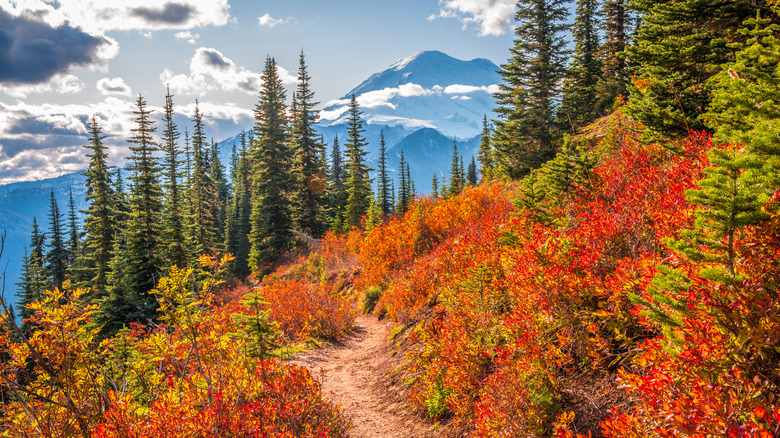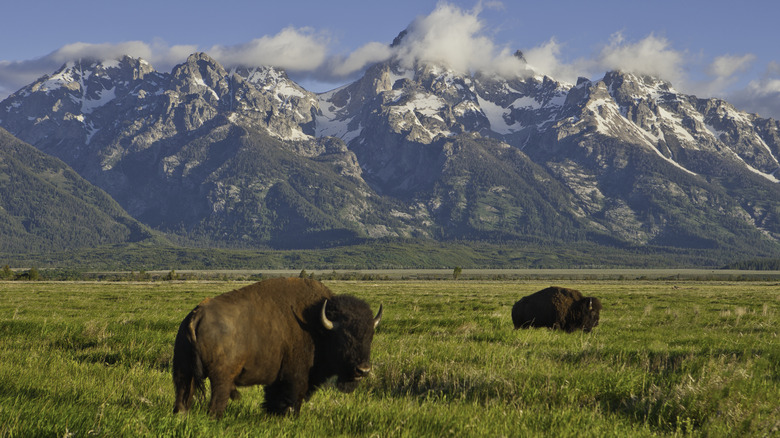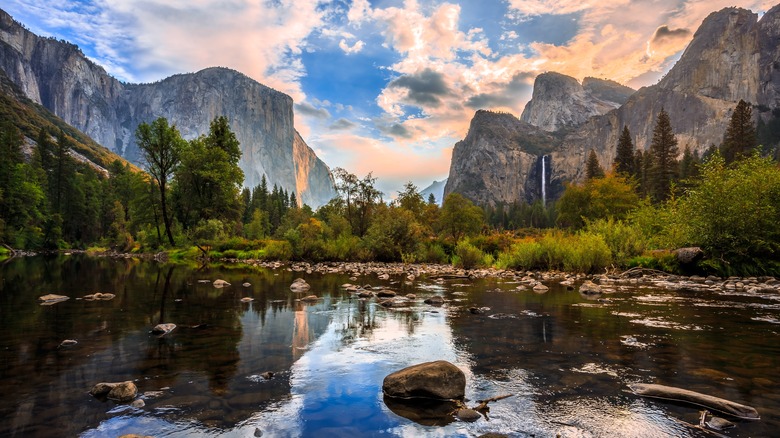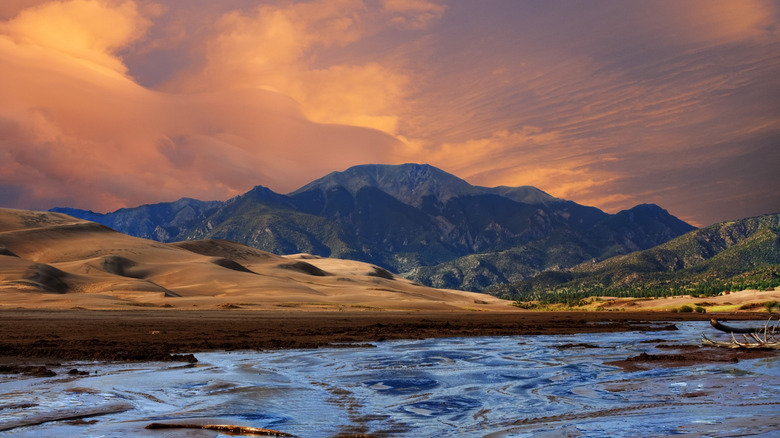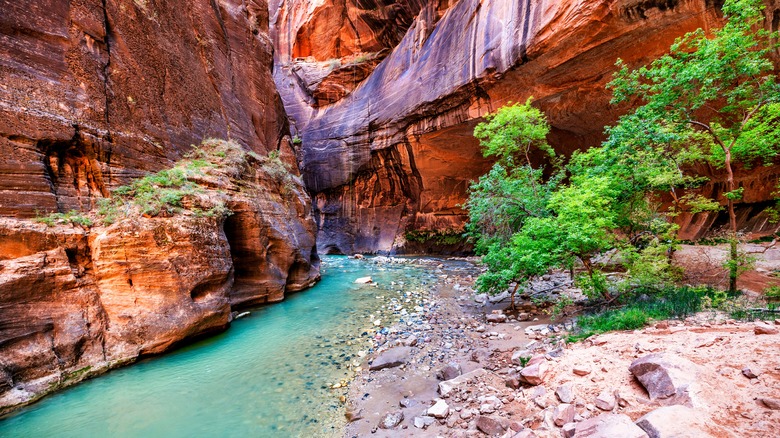National Parks That Are Most Awe-Inspiring In The Fall, According To Travelers
National parks often have closures and safety advisories, with wildfires and other dangers present even in the fall. Conditions can change on a daily basis; always check for National Park Service alerts when planning your trip and before setting out for one of these destinations.
Fall is an especially beautiful time of year at many of America's national parks. The season is special, as it lends these places a sense of greater ambiance, painting them in vivid color while carpeting the grounds with crunchy leaves. Trees sway languidly at every turn. Miles of exploration-ready trails seem more enticing in cooler temperatures. Brisk waterfalls roar in the distance. Wildflowers spring to life, bringing a pop of color to vast landscapes.
Deciding which park to visit can be tricky for travelers who wish to experience the National Park System through an autumnal lens. Based on a combination of personal experience, travel blogs, and reviews, we've put together this list of parks that offer sublime views of everything from mountains to stunning valleys. Bonus: The fall color palette is a given no matter which you choose!
Cuyahoga Valley National Park - Ohio
Cuyahoga Valley National Park drew nearly three million visitors in 2023 alone, per the National Park Service. It offers over 33,000 acres of vast meadowland, wetlands, trails, waterfalls, and more. Once marred by pollution due to the Cuyahoga River fire of 1969, it's undergone extensive rehabilitation. That's clear during fall when diverse tree species come to life. The rich reds, yellows, and oranges are especially vivid during the third week of October. That's the peak period to witness the spectacular change in maples, oaks, dogwoods, and tulips, among many other flora that dots the landscape.
It's also worth stopping to admire Brandywine Falls. Framed by lush trees, the 60-foot cascade was described by a Reddit user as "more spectacular than anything else we saw at the park." Another impressive highlight is the Towpath Trail following the Ohio & Erie Canal. Peer into the water and catch shimmering reflections of the foliage above! For those who want to sit back and relax, a ride on the National Park Scenic Excursion, open through late October, offers a leisurely way to enjoy the scenery from the comfort of a vintage train car.
Death Valley National Park - California/Nevada
Death Valley is warm during fall, but more manageable than summer with temperatures ranging from the 70s to the 90s between October and November. This is peak camping season, with Furnace Creek and Texas Springs garnering the most people. National park visitors who prefer to dodge the crowds can sightsee, hike, or stargaze from famed Zabriskie Point, a favorite for catching the sunrise and sunset.
Fall brings a distinctive drama to the usually understated park, with cacti casting longer shadows. More than just arid desert, it's diverse with its sand dunes and craggy peaks. Abby Wines, a Death Valley National Park ranger, explained to USA Today, "Most people that have not been here before think that it's all going to be sand and cactus. Well sand is less than 4% of the park."
Ranger-led tours begin in the middle of November, offering an opportunity for visitors to learn about the park's history and geological formations. Some specifically flock to the area at this time of year, as the annual 49ers' Encampment festival honors the pioneers who traveled across Death Valley in the mid-nineteenth century.
Grand Canyon National Park - Arizona
Fall is a practical time of year to visit Grand Canyon National Park. The North Rim, which closes in mid-October, features lush foliage and earthy, fiery hues along the canyon walls. With fewer crowds, it's easier to hike the North Kaibab Trail and take in scenery from Point Imperial in solitude. As the highest point on the North Rim, it provides glowing views — one reviewer on AllTrails commented that it left a "spectacular first impression of the canyon."
The Grand Canyon Railway offers a fun journey to the South Rim. From the comfort of a classic rail car (or a steam locomotive), passengers can observe the changing landscapes as the train travels through the park, gradually entering the vast canyon before arriving at Hermit Road. There, various overlooks provide exceptional views of the foliage and rock formations below.
Enthusiastic travelers have taken to Reddit to share lesser-known gems, like the fall vegetation that brightens Bright Angel Creek at the canyon's bottom, an iconic national park hike that's also one of America's most dangerous. A user described the experience as "unforgettable," while another explained, "Cottonwoods and sycamores are the predominant trees, and yes, they're beautiful in the fall. It's quite literally an oasis."
Everglades National Park - Florida
Early fall in Everglades National Park is humid. If possible, you might want to wait until late October for milder temperatures. Based on firsthand experience, the sheer variety of vegetation and animals alone makes it a special time of year to visit for outdoor enthusiasts — and it's the only place to see both alligators and crocodiles. Wildlife lovers are more likely to spy crocodiles, otters, and an assortment of other animals in the fall. Although American alligators primarily emerge in the heat, they're around during the earlier fall months before it really begins to cool down.
As water levels lower, native plants become more evident. Fall sees the emergence of regal muhly grass swaying in the breeze, painting the landscape in purple. There are also vibrant coral bean wildflowers and bold climbing asters that, in some cases, can grow over 12 feet. This is a great time to bike or hike the Shark Valley Trail and explore what's often considered the "heart of the "True Everglades." A dry limestone trail makes for great adventures, while the Bobcat Boardwalk Trail takes you through the lush forestland.
Glacier National Park - Montana
Wildlife like mountain goats and big horn sheep abound in their natural habitat at Glacier National Park during fall. With an estimated 300 grizzly bears in the park, it's not out of the question that you may encounter one during a hike or tour. Stay on the alert and be prepared to make lots of noise to scare them away!
Many Tripadvisor reviewers have shared multiple points of interest for fall photography. Recommending Apgar Village, one stated, "Wonderful sunrise and sunset photos. The long views up the lake to the mountains are beautiful." A Reddit user suggested the cool season for its epic views, explaining, "Fall became our favorite time to visit Glacier National Park as crowds got thinner, wildlife was easier to spot, and beautiful fall foliage blanketed the valleys and hills. Some of the brightest fall displays can be viewed at higher elevations."
As the park is filled with rugged trails and craggy terrains, fall is ideal for peaceful exploration. It quiets down considerably come November, and according to the Glacier Guides there are especially impressive views of St. Mary Lake and Red Eagle Mountain visible from Going-to-the-Sun Road.
Shenandoah National Park - Virginia
The Blue Ridge Mountains are the backdrop for Shenandoah National Park. Based on personal experience, taking in the breathtaking views from Skyline Drive is a privilege. The landscape is awash in vibrant tones from ruby reds to shimmery golds. The effect is so intense that it almost seems like a painter's palette. Fittingly, at these higher elevations, the rolling hills below resemble a work of art.
With temperatures hovering between 49 and 50 degrees, it's no surprise that the park sees ample crowds during fall. Some come for the spectacular wildflowers, which thrive even in cooler weather, and you may see goldenrods, asters, and witch hazel adding some extra color to the landscape. (The NPS provides a helpful wildflower calendar, too!)
If you're up for the drive, take in all 105 miles of the byway, or stop at one of the many scenic overlooks for exquisite views. Former Shenandoah National Park ranger Sally Hurlbert told AARP that Range View, at marker 17.1, is popular. "On a clear day, you see ridge after ridge after bluish ridge," Hurlbert said. "And you don't see a lot of development when you look down into the lowlands below."
Mount Rainier National Park - Washington
Some visit Mount Rainier specifically to photograph fall foliage, when the park is awash in vivid crimsons and oranges. Though wildflower meadows are robust during summer, there's plenty of plant life to enjoy in the fall. Terry Wildly, a park ranger, explained to USA Today, "The shrubs, berry bushes and other plants around Paradise, they turn this beautiful red color. And you tend to still have a period of stable weather before the snow comes. It tends to be less crowded, and you have a little bit more solitude." Among those bushes are the huckleberries and golden larch that remain vibrant even after other plants retreat.
According to Reddit users, the moderately challenging Glacier Basin Trail is among the best spots to hike. Crisp air feels refreshing as you trek by the White River, and you'll be rewarded with brilliant Mount Rainier views. Those seeking tranquility may appreciate the protected waters of Tipsoo Lake. While swimming and fishing aren't permitted, it's a wonderful spot to photograph sunrise and sunset, and enjoy the surrounding wildflowers. The lake closes in October, so add it to your list if you visit early in the season.
Grand Teton National Park - Wyoming
It's not only the change in color that makes the summer-to-fall transition so impressive at Grand Teton, the only national park in America with an airport inside of it. Hikers on AllTrails shared that they've spotted everything from mink to moose while on the Taggart Lake Loop, which also offers exquisite mountain views. Many of the animals are just passing through for the season. Elk start their journey southbound while bison begin their eastward trek. Listen for the call of the elk — that's a sign they're nearby! Monica Robinson, a Jackson Hole Wildlife Safari naturalist guide, told Travel + Leisure, "Hearing their bugle is one of the most exciting elements of fall in the Tetons."
You can also take a rafting tour of the Snake River and let a skilled guide walk you through the area's rich history — these run through September, so time your visit accordingly. And if you'd just like to soak up the views, photographer Steven Shelesky shared with National Geographic that watching the sunrise from Schwabacher Landing is an unmatched experience. "The entire Teton range is east facing, which makes for an amazing spectacle," Shelesky said. "You can see beautiful reflections of the Grand Teton on the water's surface."
Yosemite National Park - California
Visitors who venture to Yosemite National Park during fall can experience hiking, wildlife, stargazing, and so much more. Canopied by gorgeous maple, oak, and aspen trees, the park offers everything a nature lover could want. Because it's less crowded, it's an especially apt time of year to visit hotspots like Yosemite Falls and the Cathedral Range, if only for the picture-taking opportunities. For those who want water views, it's worth a visit to the Hetch Hetchy Valley to take in the shimmering lakes and hear the rush of waterfalls cascading down the cliffsides. If you've got a car, drive up to Glacier Point to enjoy breathtaking fall views of the entire valley, the falls, and the high country.
For a true glimpse of history, the Mariposa Grove of Giant Sequoias places you at the very site protected by legislation signed by President Lincoln in 1864. This was a landmark moment, as it was the first time the government recognized land for preservation. Much of the park remains accessible through October, but some areas close in November due to the threat of ice and snow.
Gates of the Arctic National Park & Preserve - Alaska
The Gates of the Arctic is unusual in many ways. It stands out because it doesn't have any of the usual tourist sites — no trails, campsites, or roads. Instead, it's completely untouched and has remained unchanged for centuries. It's a bit misunderstood because people tend to believe the lesser-known park is abandoned (and that's probably why it has the fewest visitors of any park). It's best suited to adventurous, outdoorsy types who understand how to navigate the land safely. There's also the chance you might encounter grizzly bears, musk oxen, and caribou.
The tundra brims with vivid color in the fall, providing stark contrast to the rugged mountain backdrop. One of the most remote parks on this list, it's a draw for those seeking solitude and an unfiltered glimpse of raw and untouched nature. Fall presents an excellent opportunity to see the spectacular northern lights as they light up the sky. With no light pollution, the shimmering northern lights are hypnotizing. Keep in mind that the park never closes and there aren't any amenities or cell phone service, so some know-how and skill are vital.
Hot Springs National Park - Arkansas
Set amid the Ouachita mountain range, Hot Springs National Park is especially opulent in the fall. Although many hope to experience the thermal springs firsthand, full immersion isn't possible — but touching the water is! A popular spot is the Hot Water Cascade at Arlington Lawn, where the water runs down a craggy cliff before separating into two pools. The surrounding fall foliage adds to the ambiance here.
It's worth climbing up to the open-air deck of the Hot Springs Mountain Tower for the sweeping panoramic views of the countryside and mountains. The park's extensive trail network makes it easy to explore its beauty on foot, no matter what your skill level. With its views of the water and Indian Mountain, Goat Rock Trail earns praise. One AllTrails reviewer said, "Goat Rock Trail is really easy. I hiked with a 5 and 9 year old, and they had no issues." Although fall brings its fair share of wet weather in Hot Springs, if you pack your rain gear you can still enjoy yourself.
Post-hike, escape the chill and pop into one of the historic on-site bathhouses. This is the only place you can dip into the naturally heated thermal waters — and a good excuse to relax and rejuvenate after an active day of exploration.
Great Smoky Mountains National Park - North Carolina/Tennessee
Don't sleep on the chance to visit the majestic Great Smoky Mountains National Park in the fall, the most visited in the entire country. Month by month, elevations dictate the dramatic change of color you'll see in the many mountain maples, yellow birches, and American beeches that populate the park. And that's just to kick off the season. By November, vivid scarlet oaks, hickories, and other trees vie for your attention. Rivaling that massive population (there are over 100 tree species in the park) is the impressive show of wildflowers. There are more than 1,500 types!
There are also waterfalls and vast meadows to see, along with the many birds, fish, reptiles, and mammals that call the park home. A Tripadvisor reviewer dubbed it "an amazing place to view wildlife. On our short drive through the park, with a handful of stops we saw a black bear, and got within 50 yards of an entire herd of elk." Whether for the foliage or wildlife, there's a lot to soak up during a fall day in the Smokies. If you're uncertain about where to begin, a guided mountain hike or Appalachians tour is a great introduction to the park's best sites.
Great Sand Dunes National Park & Preserve - Colorado
Desert life and mountain life collide at Great Sand Dunes National Park. Fall is the ultimate time of year to visit, as visitors can avoid the scorching summer heat and enjoy activities like hiking the towering dunes without the risk of overheating. While the steamy sand is hard to get close to during warmer months, fall's more temperate climate presents the perfect opportunity to partake in sand sledding and sandboarding.
With the Sangre de Cristo Mountains providing a rugged backdrop, vivid shades of red, gold, orange, and yellow dot the landscape. Watch for ruby dogwoods and golden shrubs that light up wooded areas. It's the perfect fall kaleidoscope if you're there for the color.
For adventurous travelers, the sand makes hiking a fun challenge. A Reddit user described their trek on the High Dune Trail as "the most unique and difficult hike I've ever done." Meanwhile, blogger Lita of the Pack said it's "one of the hardest shorter hikes that you can do." Novices, though, can take a more leisurely stroll on the Montville Nature Trail. It's short and child-friendly.
Zion National Park - Utah
Zion National Park offers the promise of the vast desert without the shocking summer heat. Those who come for the color show will appreciate Emerald Pools Trail, where the season's best hues stand out just as much as the waterfalls that await at the end of it. This is a popular hike, and fall offers bursts of orange, red, gold, and yellow that complement the canyon's red rock walls beautifully.
Lots of pretty plant life crops up at this time of the year. There's such diversity that wildflowers remain in bloom all season, while cottonwoods and maples set along the Virgin River add a lush touch to the water's edge. Follow the trail a bit and you'll arrive at Riverside Walk, the scenic destination popularly referred to as "The Gateway to the Narrows." A Tripadvisor reviewer dubbed it a "must do if you are in Zion. The fall colors were amazing and the walk is fairly easy and most of it paved (although parts of it you can walk the river edge, which is less crowded and more like hiking)."
Methodology
While it would be a privilege to visit all of the beautiful national parks in America, we haven't checked each one off our bucket list yet! For these suggestions, we relied on a combination of personal experience, travel blogs offering insight into fall-related park activities, and traveler reviews from Reddit, Tripadvisor, and AllTrails. We also turned to the National Park Service for accurate and comprehensive information about each park.







